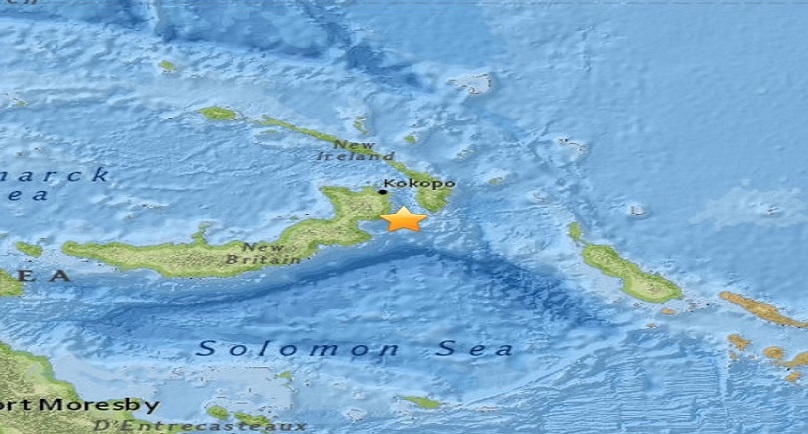Earthquake of M5.9 – 61km SSE of Kokopo, Papua New Guinea
If you were in the Gazelle Peninsula tonight, at 22:18 (10:18PM), or rather “last night” if you are reading this on Wednesday 1st, you would have definitely felt the 5.9 magnitude earthquake.
It was 32.7km deep, and shook 3 minutes after an earlier 5.6 magnitude earthquake at Taron, East New Britain. This 3 minute earlier, 5.6 magnitude earthquake occured 35km deep.
The 5.9 magnitude earthquake was considered Light shaking, for Kokopo; and Weak, for Rabaul and Namatanai. There was also a low likelihood of casualties and damage, and no Tsunami warnings.
Tonight’s 5.9 magnitude earthquake is slightly less than the 7.5 magnitude yesterday morning, Monday, at 9.48am, which rocked many homes and people in the area, bringing a wave of attention and alarm, from within the nation and around the world.
Tonight’s earthquake was:
61km (38mi) SSE of Kokopo, Papua New Guinea
273km (170mi) ENE of Kimbe, Papua New Guinea
315km (196mi) SE of Kavieng, Papua New Guinea
368km (229mi) WNW of Arawa, Papua New Guinea
777km (483mi) NE of Port Moresby, Papua New Guinea
10 minutes earlier than this, at 22:10 (10:10PM) a 5.8 magnitude earthquake was also detected at Kirakira of the Solomon Islands, 47.6km deep.
The USGS estimates that several million earthquakes occur in the world each year. Many go undetected because they hit remote areas or have very small magnitudes.
USGS state that things to look out for are: structures that are vulnerable to earthquake shaking and secondary hazards such as landslides, due to recent earthquakes.
If you want to know more and want to be aware of Earthquake alerts, you can visit the U.S Geological Survey website, where they publish real time updates on earthquakes bigger than 2.5 magnitude – http://earthquake.usgs.gov/earthquakes/index.php.
Although you can’t plan ahead for an Earthquake, if you’re living or visiting an earthquake-prone area, it is advised to be properly aware of what to do in the case of any type of emergency or natural hazard.
The U.S Geological Survey website suggest:
1. Make sure each member of your family knows what to do no matter where they are when earthquakes occur:
o Establish a meeting place where you can all reunite afterward.
o Find out about earthquake plans developed by children’s school or day care.
o Remember transportation may be disrupted, so keep some emergency supplies–food, liquids, and comfortable shoes, for example–at work.
2. KNOW where your gas, electric and water main shutoffs are and how to turn them off if there is a leak or electrical short. Make sure older members of the family can shut off utilities.
3. LOCATE your nearest fire and police stations and emergency medical facility.
4. TALK to your neighbors–how could they help you, or you them after an earthquake?
5. TAKE a First Aid and CPR Training Course.
6. MAKE your disaster supply kit. Beyond the usual torches, batteries and radios, include a first-aid kit; work gloves; sturdy shoes or boots; a week’s supply of any prescription medications you or your family might need; bank card or credit card and cash; personal identification; extra set of keys; matches in a waterproof container; map of your area; phone numbers of family and other important people (doctors, etc.); copies of important documents; special needs equipment (diapers, baby formula, hearing aid batteries; spare eyeglasses, etc.); 12 litres of water per person; three-day supply of food per person; hand tools; a portable fire extinguisher; sanitation supplies for you and your family; entertainment (toys, books, coloring books and crayons, playing cards)
7: BOLT bookcases, cabinets, tall furniture, file cabinets, etc. to wall studs. Brace or anchor heavy electronics and other heavy items. Secure items that might fall. Move heavy or fragile items to lower shelves. Fasten drawers and cabinet doors with latches or locks. Brace overhead light fixtures. Strap your water tank to wall studs and bolt down any gas appliances. Look for other non-structural steps you can take in your home and workplace to reduce your chances for injury and loss.
8. ASK AN ENGINEER about the seismic safety of your home and/or business. It’s well known that unreinforced masonry structures can fail quickly during earthquakes. An inspection by a structural engineer now can help you decide if retrofitting will help your property withstand shaking.
Some agencies provide very detailed advice on how to prepare for an earthquake, including how to be prepared, have emergency kits and emergency plans ready, like above. Additionally, some countries provide comprehensive advice too, for example:
Canada: Get prepared
New Zealand: Get ready, Get thru
United Kingdom: Emergencies Preparation, Response and Recovery
United States: Ready.gov – Earthquakes
In Papua New Guinea, local emergency services such as the PNG National Disaster Centre, or Provincial Disaster Centres, release on going awareness, information and issue warnings and assistance when required.


